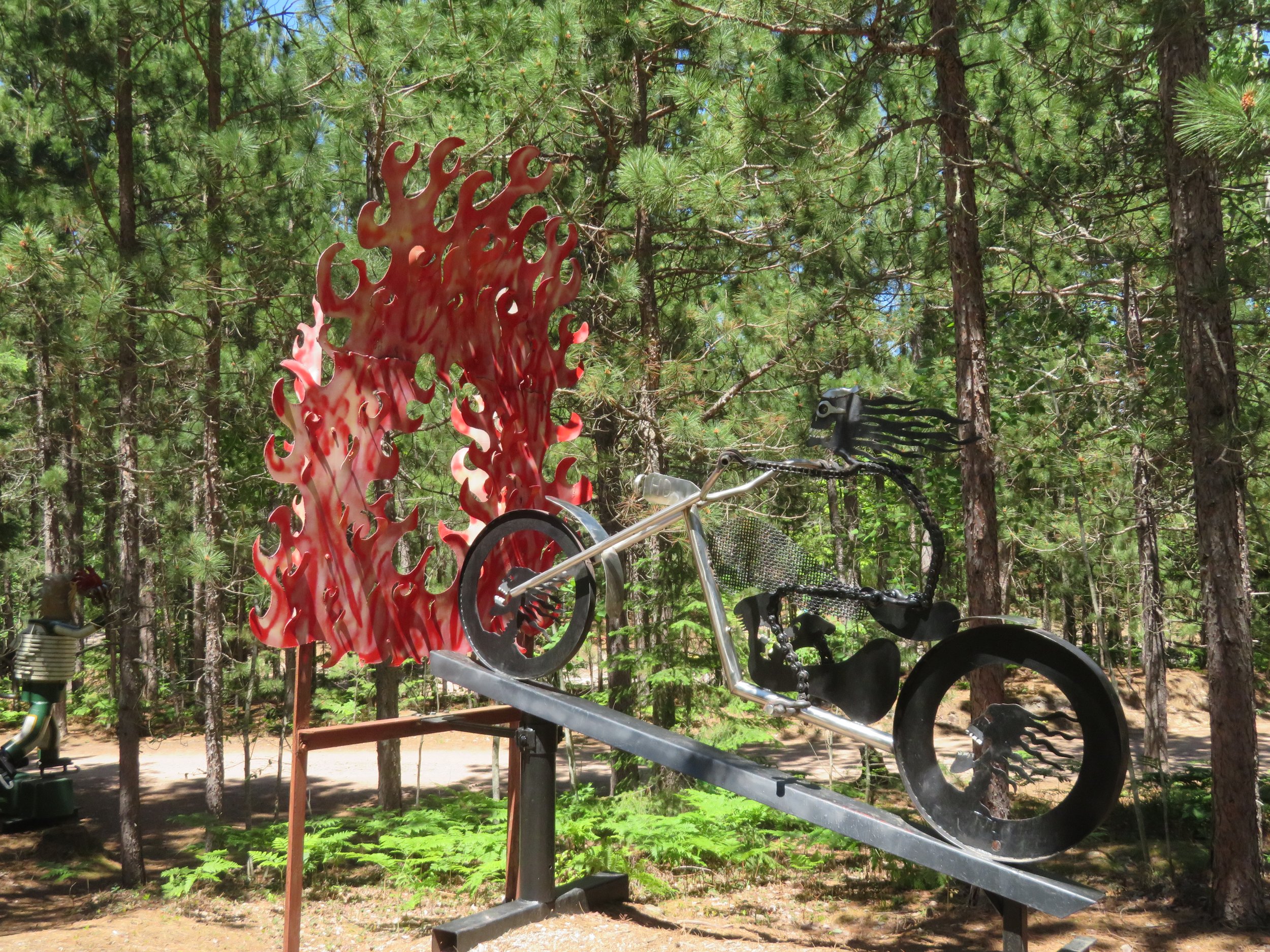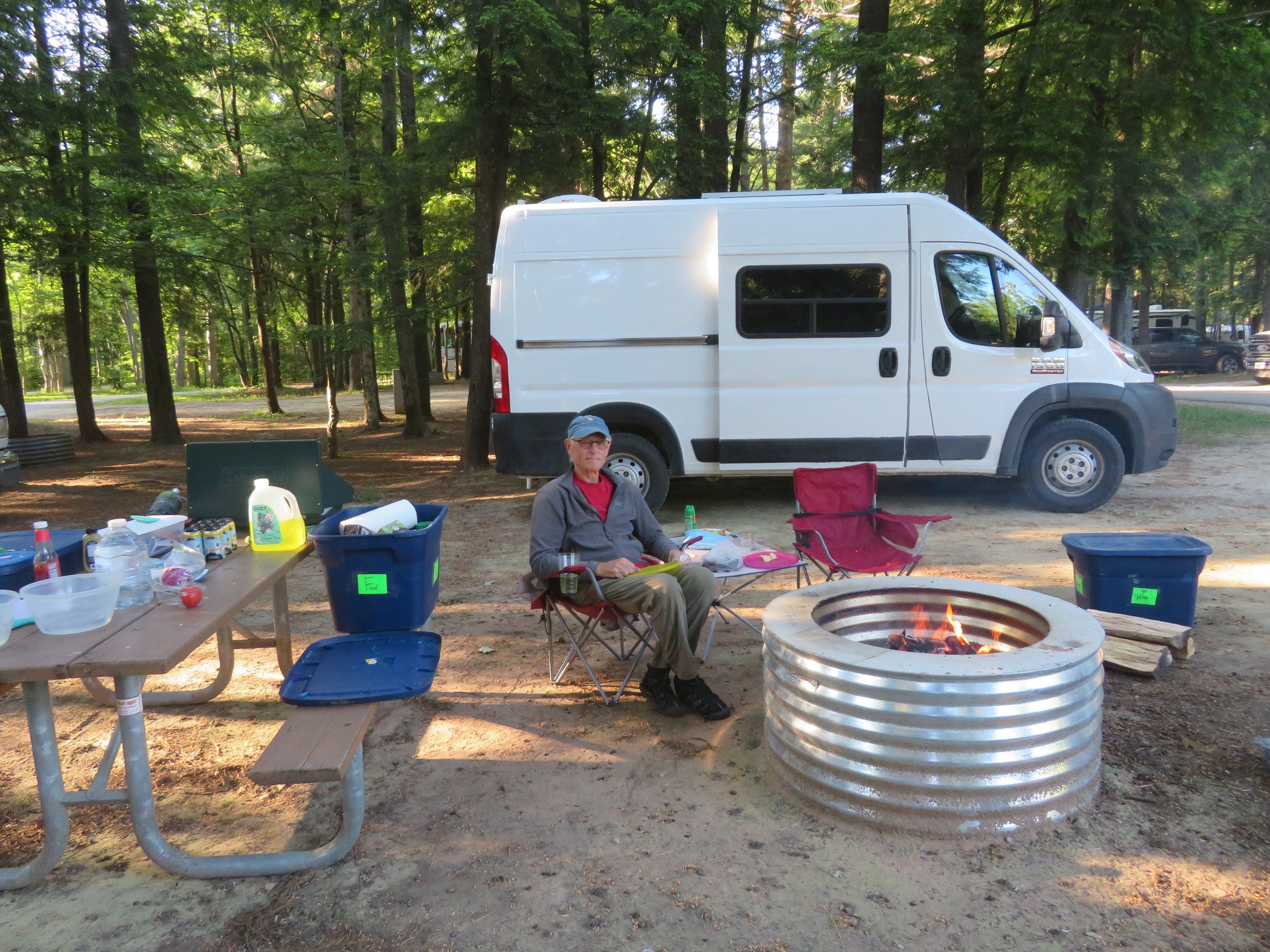Yooperland, Lakenenland & the Great Lakes Shipwreck Museum
/Day 28 - We’ve been on the road four weeks and an odometer check confirmed 4,900 miles. We left the campground mid-morning en route to Marquette. The forecast was for sunny skies, but the day was cold, windy and overcast with a high in the 60s.
On the road again, I was busy researching things to do in Marquette when David stopped the van and made a u-turn. He’d just seen Big Gus and The Yooperland Sign and figured it was a must-see opportunity. He was right. Yooperland is a free and a most unusual fun experience.
Big Gus is the world’s largest working chainsaw and Big Ernie is the world’s largest working rifle, but there was so much more to see like Eddy, the wood-burning tractor, for instance. Yooperland is a tongue-in-cheek, self-deprecating, good-natured look at life in the UP. Unique, crazy contraptions and displays of Yooper backwoods humor were spread out along a path that surrounded the Da Yooperland Tourist Trap gift shop with all the touristy Yooper kitsch you could possibly imagine. It was a hoot.
Our next stop was Marquette. Like the weather and forecasts, our plans change. Sometimes hourly on a whim and sometimes because of the weather. Today was weather-related. Our original plan was a long bike ride on the Iron Ore Trail in Marquette and camping out in the downtown park, but the day was so raw and windy, biking was not at all appealing. Instead, we drove along the lake front past huge ore docks still in use and headed to Presque Isle. The views were impressive.
Presque Isle Harbor Breakwater Light
Looking out over Lake Superior.
We wended our way back along tree-lined Lake Shore Boulevard to the Lower Ore Docks for a great view of the obsolete docks.
The weather didn’t improve, so we continued south on our route instead of spending more time In Marquette. Not far away, we came across Lakenenland Sculpture Park, a junkyard art, open-air museum. It’s free and open 24x7, 365 days a year.
This 37-acre park includes a 1/2 mile walking (or driving) trail along which Tom Lakenenland displays more than 100 of his scrap iron creations. We absolutely loved it. His art reflects his perspectives from political to social to whimsical to philosophical. It was witty, provocative, uplifting and nothing less than amazing. Take a look.
We spent the night at Tahquamenon Falls State Campground for the night. The campground is lovely and for the first time in a long time, we were able to have a campfire.
Day 29 - The day dawned sunny and cool. Our trip to the Great Lakes Shipwreck Museum at Whitefish Point was definitely the highlight of the day.
The museum is located next to the Whitefish Point Light Station and many of the historic light station buildings were also open to the public.The Whitefish Point Light Tower, in continuous operation for 155 years, is the oldest operating lighthouse on Lake Superior.
The small, but acclaimed museum opened at 10am and we arrived a bit early. At the dot of 10, just as we were about to enter, a bus load of tourists arrived and swarmed in. David purchased our tickets ($14/pp), then we opted to check out the light station buildings first while the mob was in the museum. We strolled the grounds leisurely, checking out all the open buildings including the old lightkeeper’s quarters (1861) with period furnishings and artifacts as well as journals and diaries.
Perhaps the most interesting building was the Surfboat House (1923) which displayed and explained the U.S. Life Saving Service, the precursor of the U.S. Coast Guard. The replica life saving surf boats were works of art. The associated harrowing stories of the men who participated in the life-saving efforts, however, were absolutely amazing… heroic and sometimes very sad. David’s next Blue View will go into more detail about the Life Saving Service and its incredible mission.
We finally made our way into the Shipwreck Museum. The story of the Edmund Fitzgerald was front and center as we entered the museum. The SS Edmund Fitzgerald was an American Great Lakes freighter that sank in Lake Superior during a storm on November 10, 1975. The entire crew of 29 men were lost.
The Great Lakes Shipwreck Historical Society owns and operates the professional underwater research vessel RV David Boyd. This 47-foot survey vessel surveyed and recovered the ship’s bell from the Edmund Fitzgerald on July 4, 1995 at a depth of 550’. A replica bell engraved with the names of the 29 sailors who lost their lives was replaced on the deck of the wreck. The original bell is now displayed at the entrance of the museum. Gordon Lightfoot’s The Wreck of the Edmund Fitzgerald was playing in the background and the song haunted us for the rest of the day.
The displays were well presented and interesting. One display recounted the underwater survey and salvage efforts of the historical society. Another explained diving apparatus. A video featuring Dennis Hale, the sole survivor of the steamship, Daniel J. Morell, which sank in a storm in 1966, was riveting.
After an hour or so in the museum, we headed to the boardwalk and walked along the Lake Superior shore. White Canadian bunchberry lined the boardwalk pathway until we reached the beach sand where tussocks of yellow woolly beach heather took over.
Shoes off, we trudged through the sand. Wave worn stones littered the beach along with impressive pieces of driftwood. The water was numbingly cold. As we walked, the MV Paul R. Tregurtha, “Big Paul”, a lakes-based bulk carrier freighter, sailed past. At a length of 1013.5’, she is the current Queen of the Lake, a name unofficially given to the longest vessel currently operating in the Great Lakes.
By mid-afternoon, it was time to hit the road. We stopped in Sault Ste. Marie for some supplies and congratulated ourselves on the completion of the Lake Superior Circle Route, then headed across the International Bridge into Canada.
Crossing the bridge afforded us good views of the American Soo locks as well as St. Mary’s Rapids, the reason the locks were built in the first place.
With our previous experience, we made sure we’d completed our ArriveCan on-line paperwork for entering Canada and after a wait of about 30 minutes, we passed through the border without incident.
There’s something about us being in Canada and rain. we were hoping it wasn’t because of us. As we were passing through Customs/Immigration, it started to sprinkle. By the time we turned onto the TransCanada Highway (17E), it was raining once again. We didn’t drive very far, only about 60 miles and opted to camp at a city park in Bruce Mines. The campsites were rough, but spacious and private. The campground offered very basic amenities. There were hordes of mosquitoes, all ravenous. No matter, we were snug in Blanche and spent a peaceful night with rain pattering on the roof and most of the mosquitoes on the outside.
Next time, we’ll be traveling through Ontario, Canada and heading for the nation’s capital city, Ottawa and points east. No need to bring your umbrella, it’s gonna clear up! Come on along!






































